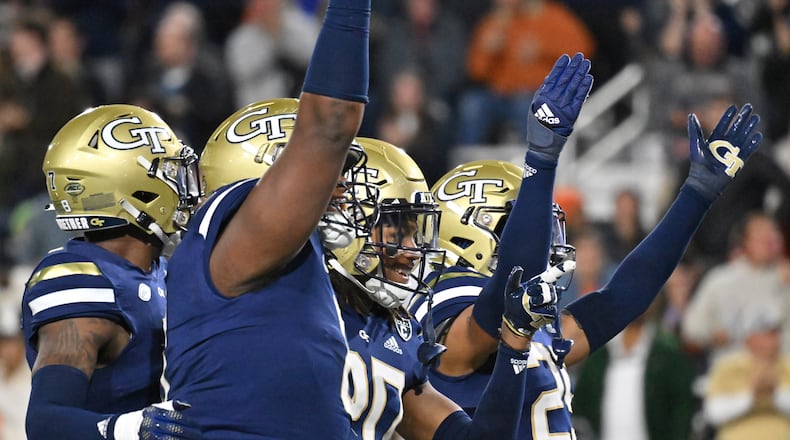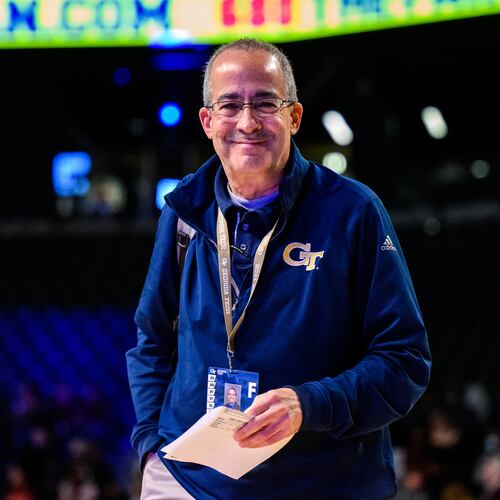Against Virginia on Thursday, Georgia Tech managed a special-teams double that it hadn’t pulled off since 2013 – blocking a kick and a punt in the same game. Defensive tackle Zeek Biggers got his hand on a 29-yard field-goal try in the third quarter, and running back Daylon Gordon snuffed out a punt in the fourth quarter. Their contributions, though, were unable to tilt the game heavily enough for the Yellow Jackets, who lost 16-9 at Bobby Dodd Stadium.
The last time that Tech blocked either a punt or a field-goal try was in 2019, against Pitt and Miami, respectively.
The last time that Tech denied a kick and a punt in the same game was the 2013 Music City Bowl (also a loss, to Ole Miss). For a team whose early-season failings were defined by its four blocked punts allowed in its first four games, it was a dramatic turn, even in a loss.
Against the Cavaliers, Tech allowed a David Shanahan punt to be deflected (it still went 40 yards) and kicker Gavin Stewart missed his first try of the season, a point-after attempt. Stewart is now 8-for-8 on field goals and 4-for-5 on point-after tries. Overall, though, the efforts of interim coach Brent Key and special-teams coordinator Jason Semore have at the least leveled the advantage in the kicking game that had previously been to its opponent’s favor.
Both blocks were the result of preparation and effort, Key explained during his weekly news conference Tuesday.
The team had been working on the field-goal block “for a long time,” Key said. On the play, defensive linemen Makius Scott and Keion White flanked Biggers, lining up tight against one another over two Virginia offensive linemen.
At the snap, Scott and Biggers charged at Zachary Teter, who did well to hold his ground against a combined 636 pounds, but Biggers was able to slide into a gap and got his right hand up to deflect Will Bettridge’s 29-yard try, which hit the right upright and fell back to the field. The play enabled Tech to stay within a touchdown of the Cavaliers at 16-9.
“It’s not about somebody jumping and getting a hand on it as much as it’s the guys doing the dirty work up front that knocked the field-goal protection back,” Key said. “Then it allows somebody to get their hand up, and Zeek was able to get his hand up and tip the field goal, which was a big play in the game.”
Gordon made his play in the fourth quarter with just under 10 minutes remaining and the score still 16-9. Key said coaches had been waiting about three series to spring the punt-block play on Virginia.
“It’s not a secret to anybody; we’re struggling on offense and we had to generate something,” he said. “I wanted to wait until it was that side of the 50-, 40-yard line so we’d have a chance then, if we blocked it, recover it, if you don’t scoop and score, to be in field-goal range and at least get points on the board right there, if not continue to be in the red zone and score a touchdown.”
Tech lined up eight players against the Virginia front at the Cavaliers’ 37-yard line, with Kevin Harris, Dylan McDuffie, Tyson Meiguez, Rodney Shelley and Gordon ambushing up the middle. Shelley, McDuffie and Gordon made it through the melee to reach Virginia’s two-man shield. With a 3-on-2 advantage, Gordon penetrated the second level, laying out and arriving just as punter Daniel Sparks made contact.
“It was right there, the perfect spot we wanted and Daylon Gordon made an unbelievable effort,” Key said. “Two guys are getting knocked over here, and everyone else did their job.”
The play wasn’t over at that point. Virginia’s Stevie Bracey (a Lovett School grad) picked up the blocked punt and could have picked up a first down had he advanced the ball 9 yards. But Kaleb Edwards punched the ball loose and Ahmari Harvey recovered to give the Jackets the ball at the Virginia 36-yard line, by 25 yards Tech’s best starting field position of the game. It was Virginia’s second blocked punt allowed this season and fourth blocked kick.
Key’s plans did not materialize, however, as the Jackets were unable to generate points off the drive, going three-and-out.
Edwards, McDuffie, Shelley, Harris and Meiguez are part of a group that has been assigned to at least three of the four primary special-teams units (punt, punt return, kickoff, kickoff return) in a revamped approach since Key became interim coach. Kenan Johnson, Sirad Bryant and Taylor McCawley are three more. Trenilyas Tatum is on two.
Led by Semore, they form a core of the kicking game unit that Key charges to play at the same level as starters on offense or defense. In Thursday’s game, there were a total of 23 punts or kickoffs, not a small opportunity to influence the game.
“The energy they played with and the competitiveness that they played with and the physicality and the speed, it was indicative of what you want your football team to be,” Key said.
Daily Jackets: The AJC presents a daily look at one news item about Georgia Tech athletics to start your morning.
About the Author
Keep Reading
The Latest
Featured


